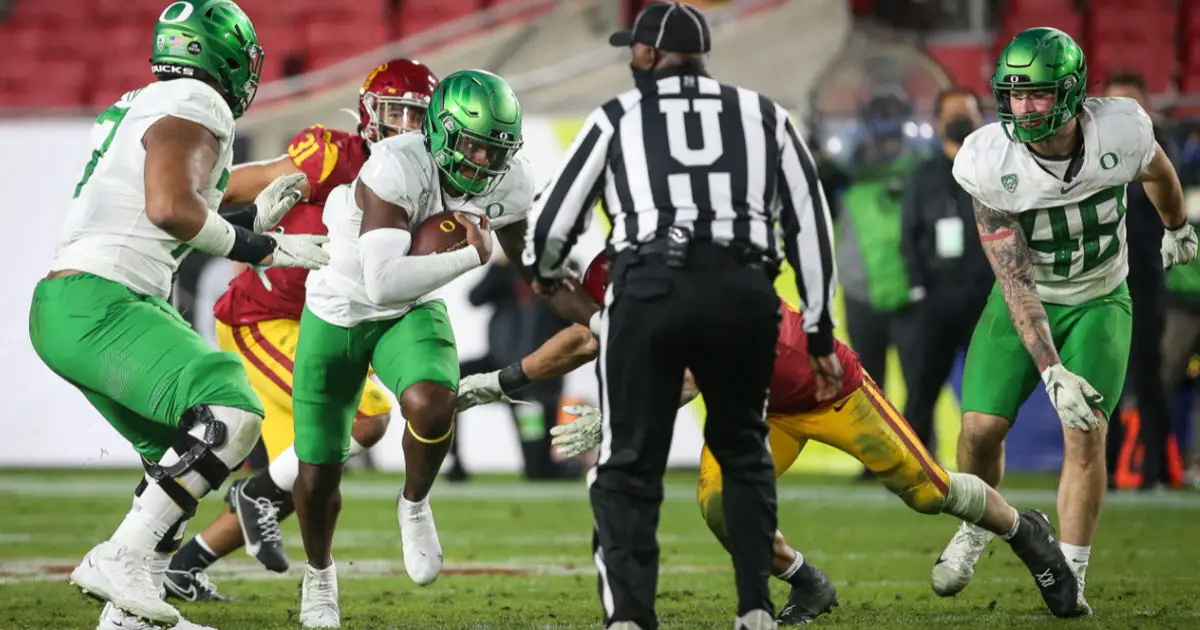When Coach Joe Moorhead was hired as the new offensive coordinator for the Oregon Ducks, folks started to wonder how often the quarterback would run in the new system. Some believed that the coaching staff would continue to curb the number of QB carries, while others believed that the end-of-season success with zone reads signaled a change. We would later find out that Coach Moorhead likes to give his quarterback between 10 and 15 carries per game.
Coach Moorhead believes in taking what the defense gives, and that includes the QB run game. Given Coach Moorhead’s historical commitment to the QB run, we can be sure the new Ducks offense will have a number of different designs to take advantage of the signal caller’s feet. Today we’re going to look at one that, for simplicity, I’ll refer to as the shovel option RPO.

Shovel Option RPO
The shovel option RPO combines the classic shovel option with a screen to the perimeter. For those who aren’t familiar with the shovel option, it is essentially an inverted version of the speed option; instead of a backward pitch to the running back, it is a forward shovel pass to the running back. The play allows the running back to get downhill a bit quicker and gives the QB a little more open space.
In the diagram above, you can see how the reaction of the defensive end dictates what the QB does with the ball. If the defensive end takes the quarterback, the ball is simply shovel-pitched inside to the running back.
As far as the offensive line goes, they are tasked with performing a basic, power-blocking scheme. The entire frontside of the line performs down blocks, with the tackle climbing to the inside linebacker. The backside guard pulls to the frontside c-gap and becomes the lead blocker for the running back. The backside tackle pass sets, taking away any backside pursuit, while the TE cuts off pursuit at the second level.
If the defensive end crashes (as above), the QB keeps the ball and will then choose between two new options. An overhang defender becomes the second key, and the QB will decide if it’s best that he run the ball or to throw it out to the quick out/arrow screen.
In the video above, the defensive end commits to the QB, leaving the RB with space to work. If the end had committed to the running back, the screen to the outside would have been open for good yardage because of the favorable numbers. The hat-on-hat blocking on the perimeter would have sprung the inside receiver for a big play.
The shovel option RPO is a unique play that works to put the defense at a numbers disadvantage. The idea is to make the defense guess wrong at two different levels and to be plus-one in blocking(having one more blocker than defenders) by reading defenders.
Coach Eric Boles
Newark, OhioTop Photo by Kevin Cline
 Phil Anderson, the FishDuck.com Volunteer editor for this article, is a trial lawyer in Bend Oregon.
Phil Anderson, the FishDuck.com Volunteer editor for this article, is a trial lawyer in Bend Oregon.
Eric resides in Central Ohio, just outside the capital city of Columbus. He is a former offensive assistant and return game coordinator for the Ohio State – Newark/Central Ohio Technical College Titans football program.
He is an OSU-N graduate, having completed a Bachelor of Arts program in psychology.


